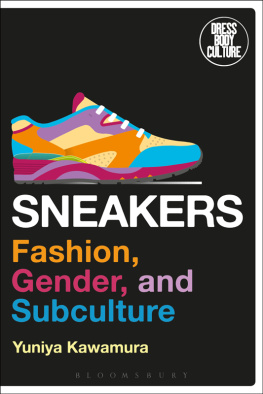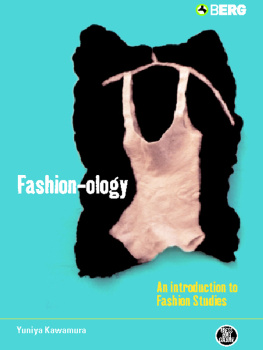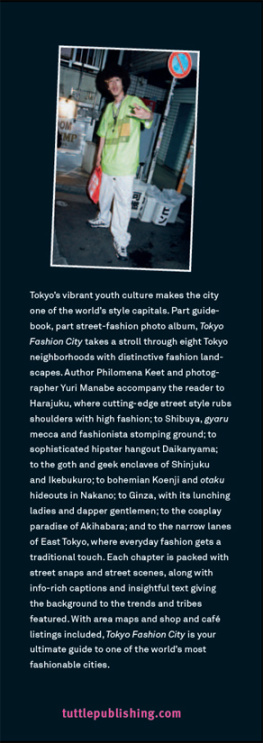
English edition
First published in 2012 by
Berg
Editorial offices:
50 Bedford Square, London WC1B 3DP, UK
175 Fifth Avenue, New York, NY 10010, USA
This electronic edition published in 2012 by Bloomsbury Publishing Plc
Yuniya Kawamura 2012
All rights reserved
You may not copy, distribute, transmit, reproduce or otherwise make available this publication (or any part of it) in any form, or by any means (including without limitation electronic, digital, optical, mechanical, photocopying, printing, recording or otherwise), without the prior written permission of the publisher. Any person who does any unauthorised act in relation to this publication may be liable to criminal prosecution and civil claims for damages
Berg is an imprint of Bloomsbury Publishing Plc.
Library of Congress Cataloging-in-Publication Data
Kawamura, Yuniya, 1963
Fashioning Japanese subcultures / Yuniya Kawamura.
pages cm
Includes bibliographical references and index. 1. FashionJapan. 2. Fashion designJapan.
3. SubcultureJapan. 4. JapanSocial life and customs. I. Title.
GT1560.K35 2012
391.00952dc23 2012004413
British Library Cataloguing-in-Publication Data
A catalogue record for this book is available from the British Library.
ISBN: 978 0 8578 5216 8 (e-book)
Visit www.bloomsbury.com to find out more about our authors and their books
You will find extracts, author interviews, author events and you can sign up for newsletters to be the first to hear about our latest releases and special offers
To My Family
Contents
PLATES
TABLES
My appreciation goes to the Fashion Institute of Technology (FIT) of the State University of New York for granting me a sabbatical leave and relieving me of my teaching duties during the spring 2010 semester to work on this project. I have been working on this topic since 2004, and I needed the time to concentrate on my fieldwork in Tokyo so that I could start writing a book. I am grateful to Valerie Steele, director and chief curator of the Museum at FIT, for giving me the opportunity to contribute an article, Japanese Fashion Subcultures, to her exhibition catalog Japan Fashion Now! (Yale University Press, 2010) and to give a presentation at the exhibition symposium in November 2010.
I am thankful to all my colleagues in the Social Sciences Department who are supportive of my work: Yasemin Celik, Paul Clement, Luis Zaera, Ernest Poole, Spencer Schein, Meg Miele, Joseph Maiorca, Roberta Paley, Praveen Chaudhry, Emre Ozsoz, Dan Benkendorf, and Jung-Whan (Marc) de Jong. Students in my Clothing and Society and Cultural Expressions of Non-Western Dress/Fashion classes provided a valuable sounding board for the development of my ideas.
My gratitude also goes to Hiroshi Ishida, my former professor at the Graduate School of Arts and Sciences, Columbia University, who is now at the Institute of Social Science, Tokyo University, for sponsoring my residence there as a visiting fellow from January to August 2010. He also gave me the opportunity to speak at his Contemporary Japan Study Group in June 2010. The feedback I received from the audience was constructive and encouraging. While I was in Japan, Reiko Koga of Bunka Womens University and Takashi Machimura of Hitotsubashi University also invited me to present my research in their graduate classes.
Discussions with my former classmates in graduate school, Takeshi Wada of Tokyo University, and Tsutomu Nakano of the Graduate School of Business at Aoyoama Gakuin University, have been very productive.
I have given a number of presentations on Japanese fashion and subcultures at several academic conferences, such as at the European Sociological Association conference in Milan; the First Global Conference: Urban Popcultures in Prague, Czech Republic; and the Dressing Rooms: Current Perspectives on Fashion and Textile conference, in Oslo, Norway. I am grateful to the Center for Excellence in Teaching and Scott Stoddart, dean of liberal arts at FIT, for funding many of my conference trips.
I thank all the organizations and museums that invited me to give a presentation on my book even before its completion: Asia Society in New York; Parsons the New School for Design; the Museum of Arts and Design in New York; the University of California, Los Angeles; Potsdam University in Germany; the Textile Museum in Washington, D.C.; the Japanese-American Association of New York; the Japanese-Americans, Japanese in America in New York; Copenhagen Business School in Denmark; and the Centre for Fashion Studies in Sweden.
This is the fourth book that I am publishing with Berg, and it is always a pleasure working with their efficient and professional editorial team. I am grateful to Julia Hall, Anna Wright, Emily Medcalf, Noa Vazquez, Agnes Upshall, and Ian Buck at Berg.
I am thankful for the gracious assistance provided by the library staff at the Fashion Institute of Technology, Columbia University, and Bunka University.
My appreciation also goes to my friends in TokyoYutaka Ishibashi, Takuo Tsuchida, Hideki Shimizu, and Satoko Iyewhom I called and e-mailed whenever I needed a distraction from writing.
I am eternally indebted to all the members of the Japanese subcultures who sat down with me and told me their candid stories and experiences. This book would not have been possible without their contributions. I am especially thankful to Momo Matsuura, Zuki, Haru, Yusuke Arai, Sphere, Ayumi Saito, Yutaka Toyama, Mayumi Abe, Sara, and Silvia Nodari for allowing me to use their original pictures.
I dedicate this book to my family, Yoya, Yoko, and Maya Kawamura, who have always been there for me whenever I needed them. I could not have completed this book without their love and encouragement. I am who I am today because of them.
Yuniya Kawamura
New York and Tokyo
Japanese street fashion and youth subcultures have been topics of interest for many journalists, editors, bloggers, museum curators, and photographers both in and outside Japan (Aoki 2001, 2006; Evers, Macias, and Nonaka 2007; Godoy 2007, 2009; Keet 2007; Narumi 2010; Yoshinaga and Ishikawa 2007), who provide fascinating accounts as well as photographs that capture everyday clothes worn by ordinary but fashionable Japanese boys and girls on the streets. Japanese youth dress is indeed visually appealing, but more than that, it is vital to the theoretical understanding of subcultures to which many of the youth belong. My intention in writing this book is to provide theoretical frameworks within which the Japanese subcultural phenomenon can be analyzed. My study will make a contribution as a case study to subcultural studies and theories in general. The scholarly literature on Japanese fashion often focuses on major Japanese designers (English 2007, 2011; Fukai et al. 2010; Kawamura 2004; Koda 2008; Kondo 1997; Mears 2010; Mitchell 2006), such as Issey Miyake, Rei Kawakubo, and Yohji Yamamoto, or traces the cultural and social history of Japanese kimono or textiles (Brandon et al. 2005; Dalby 2001; Imperatore and Maclardy 2001; Munsterberg 1996; Slade 2010), and they do not pay much attention to Japanese youth fashion.
Thus, the purpose of this book is to fill the void between academic and non-academic perspectives since Japanese youth subcultures and their unique stylistic expressions as a research topic deserve scholarly and intellectual considerations just as punks, goths, mods, skinheads, and hippies in the West are studied in scholarship on youth subcultures (Baron 1989; Brake 1980; Haenfler 2006, 2009; Hebdige 1979; Hodkinson 2002; Issitt 2009, 2011; Muggleton 2000). My focus is not on any street fashion, which is a term used loosely to indicate any type of youth fashion. My attention is specifically on the members of different subcultural communities in Tokyo and their outward appearances. Like many other subcultures in the West, I argue that the Japanese subcultural phenomenon is an ideological one. By popularizing a subcultural style as a fashion trend, the legitimate taste in fashion is transforming and expanding with the help of the related industries, and they together constitute an institution and establish an alternative fashion system that goes against the mainstream system of fashion.
Next page










